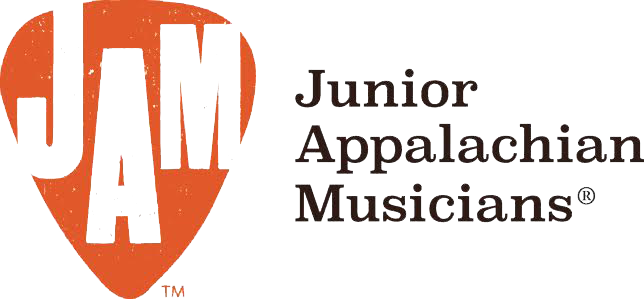The JAM Program Model
JAM is an after-school program for children in grades 4 – 8 and beyond that introduces music through small group instruction on instruments common to the Appalachian region, such as fiddle, banjo and guitar. Each JAM program is individually operated and funded. By affiliating with the JAM organization, each program is eligible to receive support and resources for free, and is licensed to use “Junior Appalachian Musicians (JAM)” to identify their traditional music education program.
Junior Appalachian Musicians ® is a registered trademark of Junior Appalachian Musicians, Inc.
In JAM, instrument instruction is often augmented by dance and vocal instruction as well as string band classes and group enrichment lessons, which introduce children to additional Appalachian culture and history. The JAM program model provides children with opportunities to not only learn traditional music, but to also perform in small and large groups. Field trips, visiting artists and an introduction to the rich history of music unique to each local community further supplement program offerings. Each JAM program is encouraged to foster musical traditions by teaching local styles of traditional mountain music and dance to children. Instructors are also encouraged to teach students to learn music by ear, as to preserve oral traditions as much as possible. Other teaching methodologies and instructional skills are covered in regional professional development and training sessions held multiple times per year and hosted by JAM. JAM also encourages student engagement across programs with regional performance and learning activities throughout the year. For a full list of benefits to affiliates, click here.
JAM believes that all children should have access to traditional old time and bluegrass music. It is recommended that each program provide financial assistance through scholarships to children in need. The program model bases tuition fees on student lunch status: $10/week for full pay children, and $5/week for reduced pay children.
Class sizes typically have a student teacher ratio of 8:1 or less. JAM mandates that each affiliated program conduct criminal background checks on their instructors, directors, and other staff members and volunteers. Programs must be held in public facilities accessible to the community. Junior Appalachian Musicians, Inc prohibits discrimination against any persons on the bases of race, color, national origin, disability, sex, gender identity, religion, reprisal, political beliefs, familial or parental status, and sexual orientation.
For a full listing of affiliation requirements, click here.
History of JAM
Realizing the need to preserve a vital aspect of mountain culture as well as the need for positive activities to underserved youth, Helen White, then a guidance counselor at Sparta Elementary School, founded the first JAM program in Alleghany County, NC in the spring of 2000 with help from other local musicians and educators. Interest in the program spread rapidly with assistance from the National Endowment for the Arts, NC State Arts Council, Blue Ridge National Heritage Area and “The Crooked Road – Virginia’s Heritage Music Trail.”
In 2007, the Z. Smith Reynolds Foundation provided funding to allow the development of a regional infrastructure. The Dana Foundation, Virginia Commission for Arts, the Virginia Foundation for Humanities, the Blue Ridge National Heritage Area, the National Endowment for the Arts, the Harris and Frances Block Foundation and the Tides Foundation have provided funding for materials development.
“Junior Appalachian Musicians” was incorporated in 2008 as a non-profit 501(c)3 tax exempt corporation to promote a shared vision of JAM and to provide an umbrella through which to offer resources, training materials and activities to benefit programs individually and collectively. Currently in nearly 30 locations in North Carolina, South Carolina, Tennessee and Virginia, JAM affiliates are providing access to the joy of music to thousands of youth while instilling renewed interest and pride in their heritage.
Interested in learning more about JAM? Click here.
